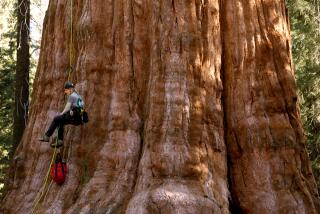Florida’s Palms Felled by Disease
- Share via
MIAMI — Florida without tropical palms? It’s like Tom Cruise without hair. The San Diego Zoo without animals. Yellowstone without Old Faithful. New York City without theaters.
A disease known as lethal yellowing is decimating many of the varieties of palms in southern Florida and has all but wiped out the state’s famous Jamaica Tall coconut palms, the trees that tourists try to get in the background of their photos to make friends envious in winter.
A state agronomist, Bill Theobald, working out of a small rock building that looks like an annex to the Alamo, is trying to stop some of the losses by propagating a different kind of coconut palm.
In his office at Florida’s coconut-seed orchard, there is no fancy equipment, no $30,000 pollen extractors. “Here’s our pollen extractor,” Theobald said, showing off an $8 rolling pin and a $2 bread board.
For centuries, coconut palms have been used in impoverished areas of the world for making thatched roofs, dishes, flour, cooking oil and even a powerful liquor.
But they have lost their importance in a plastic, prefabricated civilization. Bulldozers in southern Florida are mowing down the Jamaica Tall and other palms to make room for shopping centers, parking lots and housing developments.
Now lethal yellowing is threatening to wipe out the few remaining Jamaica Tall coconut trees. Twenty-two other kinds of ornamental palms are at risk too.
Theobald, with the help of just three workers, is trying to introduce a hybrid coconut palm produced in Jamaica that is highly resistant to lethal yellow leaf. Otherwise, he says, Florida is not too many years away from being “just sea, sand and concrete.”
In his mind, Florida without palms would be like North Carolina without its pines, Massachusetts without its elms, Mississippi without its magnolias, Theobald said as he took time out from his work.
Perched two stories high on a ladder in a coconut grove, he was busy dusting the female flowers of one species of coconut tree with the pollen from the male flowers of another species of coconut.
Lethal yellowing is believed to have worked its way over from Pacific islands to Central America. After sweeping through the Caribbean, it reached Key West in 1949 and Dade County in the 1970s.
The disease had devastating effects in the Caribbean islands, where people have many uses for the coconut tree. “You would have trouble finding something in nature that is as useful as the coconut tree,” Theobald said.
Coconut leaves are used for weaving mats, thatching roofs and making chairs, mattresses, baskets, hats and room dividers. The hard shells make cups, ladles, spoons and flowerpots. Holes are punched in shells to make sieves. The coconut oil is used to make soap and cooking oil. The hard shells and the husks are used for fuel.
The coconut meat provides coconut flour for bread. Ground up and boiled down, the meat becomes coconut sugar and coconut candy.
The terminal bud, called palm cabbage, is considered a delicacy.
The root is chewed as a narcotic.
Because coconuts are so highly valued in the Caribbean, people in Jamaica posted armed guards to protect healthy trees from coconut rustlers, Theobald said.
In southern Florida, palm trees felled by lethal yellowing have been replaced largely with shade trees such as the live oak, black olive or mahogany. As handsome as these trees might be, they do not match the tropical appeal of the coconut palm and other ornamental palms.
Lethal yellowing is caused by a virus-like microplasma, an organism that enters a cell and blocks cell production. It hits the youngest tissue first. Male flowers are blackened and deformed. The tree’s young coconuts start to fall off. The lower fronds turn yellow first. Then the top falls off. The disease is carried by an insect called a leafhopper.
The most resistant coconut palm found so far is the Maypan, a cross between a Malayan Dwarf and the Panama Tall. They were imported initially from Jamaica.
One problem with the Maypan is that seed production is dependent on hand pollination of each individual floret. Homeowners cannot collect the coconuts from mature Maypans and plant them to produce more Maypans.
In recent years, the state orchard that Theobald tends transferred its Maypan seedlings to state lands, but this year, because of state budget cuts, the seedlings will likely be sold to the public.
Some legislators have suggested that the entire coconut tree project be eliminated. What would that mean for Florida?
“A great business in plastic trees,” Theobald said.
More to Read
Sign up for The Wild
We’ll help you find the best places to hike, bike and run, as well as the perfect silent spots for meditation and yoga.
You may occasionally receive promotional content from the Los Angeles Times.






